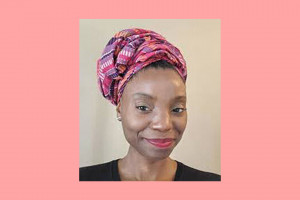
Libya Doman has been named 2020 Virginia Art Educator of the Year and Virginia Elementary Art Educator of the Year by the Virginia Art Education Association. She earned a certificate in 2003 from Moore College of Art & Design in the post-baccalaureate program.
As a cultural proficiency facilitator, Doman strives to normalize talking about issues of diversity in the classroom. She encourages her students, who come to Virginia from all over the world, to “actively be part of the solution.”
Doman talked with Communications Intern Samantha Weinraub about her background, perspectives and inclusive practices in education.
How did you get started in your career?
I had a degree in art history from Spelman College, a historically Black, women’s school. I had decided that the museum path I had planned was not truly what I wanted at that time. I saved my money and moved abroad. One day, walking over a bridge in Paris, it hit me that what I loved most was art and kids. I decided that night—in the City of Lights—that I would pursue my art education certification. Moore College of Art & Design, which I’d known about since I was kid growing up in Philly and South Jersey, was the program for me.
Using Moore’s model of research and immersion, I have developed strong practices in working with English learners as a culturally responsive educator who has learned trauma-informed approaches. I have been so pleased to watch from a distance as Moore's post-baccalaureate degree evolved into a master’s degree in Art and Special Populations in which they openly address the various forms of bias, including ones I have experienced.
How do students view the artistic process, and how do they incorporate their own views into art? Does your background and experience play into current roles and expressions in teaching?
A few weeks ago I was doing a lesson that was formally about drawing a dream home for someone (family, themselves, others in need). I asked a class to tell me how homes are the same and/or different. The kids were listing architectural elements like rooftops, domes, picture windows and bricks. Then, one 5th grader wrote in the chat, “Water bill.” I was struck. I asked her to share more. She said, “Rent, the light bill.” We ended up having this amazing conversation in part because of her brilliance but also because I was aware that this lesson was about so much more than a drawing of a house on a sheet of paper.
Even before #blacklivesmatter became a common and accepted refrain in mainstream settings, many art educators have been working to diversify the artists shown in classes or other art spaces. I try to always highlight multiple perspectives in every unit. I have a practice of showing students pictures of the real artists. I also include demographic information. It is one of the ways that I remind kids that artists are real people who live or have lived in the world just like us.
How long have you been teaching? What is your favorite thing about teaching art? How do you include social justice and culturally responsive art into your classroom?
I’ve been teaching for 18 years and one of my favorite things about teaching is that I am always evolving.
Kids talk to me about issues related to diversity frequently. One reason is because as a cultural proficiency facilitator, I have a lot of practice talking openly about issues of diversity. In some school settings, I am one of a few African Americans they encounter, so for those students I embody issues of race.
One of my biggest jobs as an educator is to not inadvertently tell a student or participant that talking about race or gender is taboo. I want to normalize talking about issues of diversity.
I have students who have said “Black” in a whisper. When I am drawing a self-portrait, and select a brown, I am so deliberate in talking about the delicious milk chocolate brown of my skin. Most of my younger students want to get their hands on that chocolate brown! When I normalize the idea that my skin is also worthy to be praised, I'm countering a narrative of anti-Black racism.
This is my fifth year at a school in which I have the privilege of showing up as an African American woman with a majority of the students who have Central American backgrounds. Their families are largely from Honduras, Guatemala and El Salvador. When I came to my current school, I was very likely to generalize by calling my students "Latino." Latino is the most common way this demographic information is captured on official forms.
I was reminded that it is imperative to allow people to name themselves. Students and families will let you know who they are if you are ready to listen. Who they are might be very specifically Honduran, or Honduran-American, but maybe not Latino.
Self-identification is not just about ethnicity and race. It extends to many areas of diversity and inclusion. For instance, gender pronouns: he, she, or they? Gender is complex. I am a woman. But I'm not THE model of a woman. Who is? I am, however, the person most qualified to tell you exactly who I am.
Let's consider disabilities. I used to be a strong supporter of the "people first" model, as in "student with special needs." Now I know folks who self-identify as differently abled or disabled. Autism, a person on the autism spectrum, or atypical are all claimed by different folks. Who am I to tell them they are wrong?
